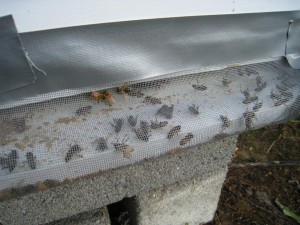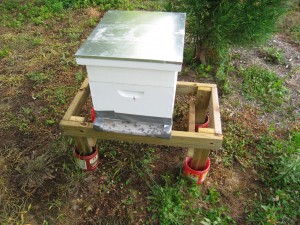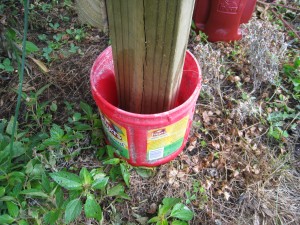Failures and Successes : Moving Established Hives and a Rob-out
The weather in Richmond, Virginia continues to be miserable, although the temperatures dropped a bit today from the upper-90’s to the upper-80’s in eastern Henrico. The drought is really bad. I noticed some golden rod blooming, but most other things look like they are more interested in simply surviving as opposed to putting on blooms. A big front is headed our way and appears to be creeping to the east. We might actually get some rain tomorrow!
Today was a busy day in my bee world. The first story centers around a trip to Charles City and a rob-out. I have decided to reduce the number of established hives in my home yard (I suppose I should call it the Wilton Apiary, as I now have three locations with hives.) I had moved two of my most recent splits (Apache and Bob) to Charles City last weekend, to hopefully cease the robbing, to a small pond on my folk’s land. This is what I will call my Goose Pond Apiary, after the natural swimming hole that my grandfather built on the property. I had identified another spot, about a mile or so away, on a piece of land that my father and aunt own, which we call Mountcastle, so this will be my Mountcastle Apiary. It is here that I wanted to place two of my established hives, along a cut-over that is about 4 years old and about 400 yards from a beaver pond.
Although I have moved Nuc’s and single super (always Deeps) hives before, I had never moved an established hive. All of my established hives are working two deeps (full) at least. I cannot pick that weight up, so I needed to get them on a trolley. To do that, I would have to break them apart. Sealing them up for the move and then breaking them apart to move them would have defeated the purpose (bees would have surely been everywhere.) So, I took a different course of action.
Around 10 am, yesterday, I broke the Albo hive apart and placed them on the trolley, about 3 feet from the original location (and 1 foot down). The bees were pretty good about it, considering my normal adventures with opening hives this time of year, and everything went smoothly. I now had the hive setup, on the trolley, and the foragers were slowly finding their way back to it. The plan was to come back after dark, screen up the entrance and use a tie-down to ratchet the whole thing together and then ratchet it (again) to the trolley. Of course, it didn’t work out as expected.
Right at dark, I checked on the hive to discover that they were bearding all over the front of the bottom deep. A solid mass of bees – in the dark! I kept going back every 30 minutes and could see no change. I could not screen up the entrance without losing a ton of bees. Finally, I went to bed and set my alarm for 4 am to check again. I vaguely recall the alarm going off and being very annoyed with it, as I yanked the plug out of the wall and went back to sleep…
So, come morning, I went out to check on them. The beard was gone at 6:15. I was somewhat frustrated and didn’t even screen up the entrance. I toted the hive onto the trailer and off to the Mountcastle Apiary I went! I was able to get them on a decent spot on the ground and step back and watch. After a few moments, several bees came out and began to fly around. This hive has a ton of stores, brood and eggs. No matter what happened in this ride, they should be fine. One hive down, one to go.
Since I was in Charles City, I decided to swing by the Goose Pond Aviary while I was at it. I wanted to see how much syrup the hives had eaten. The Bob Hive was fine. It was still working on the syrup. I briefly looked in and there were a lot of bees covering the four frames. Things looked good. The Apache Hive, however, looked desolate. I opened her up and found about 50 bees and no honey, brood or anything (except a few small hive beetles…). Amazingly enough, I also found the daggone queen. Bees were piled up in the front of the deep and in the robber screen. The food was all gone. It appeared to me that I had a definite rob out. This hive was suffering to begin with. I guess moving it did not help out much.
I took the hive back home and decided to try to start one more split. It’s unlikely that I can get it to stick, but this time I will not be dropping a frame of honey into it. I actually took one frame of bees and capped brood, each, from Geronimo and the Queen-right Westover split (I am going to simply call this one Westover from now on, since they still have that huge, black queen that I picked up with my first swarm) and one partially drawn frame that had some bees on it from the Queen-less Westover Split. I now have them in a Nuc, completely sealed up (I sprinkled a few drops of water on the top of the frame and put them in the shade.) They are not really ‘sealed up’, as they have a robber screen (so they have access to air), but they cannot leave the hive, nor can anyone get in. My plans for this one will hopefully be to combine it with the remains of the Apache Hive tomorrow (or I might just catch the queen and drop her into the queen cage that I picked up from Bobby, doing a normal queen introduction.)
I returned home for some serious work. I needed the frames for the new split and this was the perfect reason to go ahead and do some inspections. I have started to track my inspections in a notebook, since I have too many hives to track them well in this blog, so the highlights include:
The Westover split is strong. They are working on the top Illinois Super (they are running a Deep and a Medium super) with lots of honey and pollen stored.The William Byrd hive (the queen-less Westover split) is slam full of bees, although I know that they are fairly old. I did notice where one of the queen cells was torn apart, although I could see no evidence of the other two that I noticed 19 days ago. After some hard looking, I found a frame of eggs. I never did see the queen and did not see any capped brood or larva, but I am thinking that is normal. This will be my first successful queen rearing in my own yard, so I am very hopeful. The William Byrd hive has so much nectar and honey stored that I was tempted to take some, but I didn’t. When I split them, I gave them a few of the frames from the Medium Super that was on top of the parent hive. The next day, I dropped a deep between the bottom deep (with all of the bees) and the Illinois super. They have so far only done very minor work on the middle deep. I took two frames of honey and moved them up into the top deep and replaced those with the barely drawn frames from above. I hope this will encourage them to begin work on these frames.
As expected, the Geronimo Hive was very strong. They had nearly finished drawing out the two frames of foundation that I snagged from them for the original Apache split. They had several frames that were solid pollen (and I noticed several bees laden down with pollen on the frames.)
The final note regards the Blue Cottage hive. They have grown respectably to a 4.5 frame Nuc. I moved them to a full deep today and took the Nuc’s for my new split experiment. Unfortunately, I did find wax moth larva on the bottom and killed them all. I will have to watch that hive a bit closer. I am thinking about moving it, along with the Westover Hive, out to my two new apiaries this evening. We shall see!



